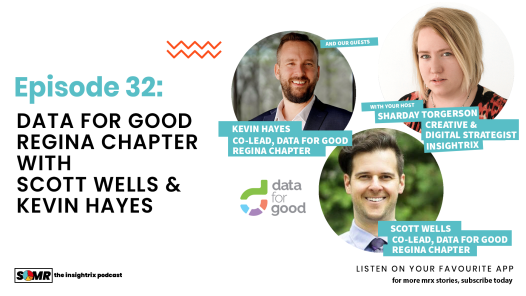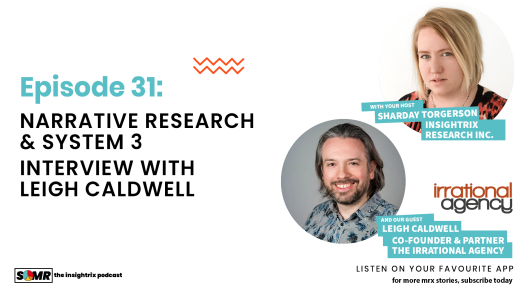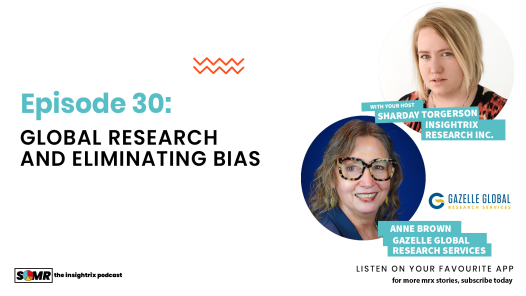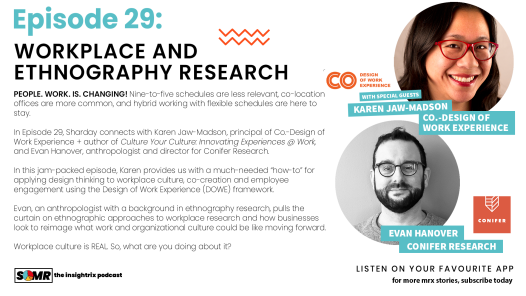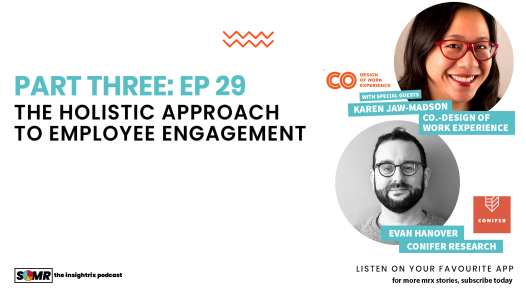Sharday: I would like to welcome today our guest on today’s episode, Mike Moussallem, partner at Explorer Research with offices in Toronto and Chicago. So at Explorer Research, Mike leads the VR methodology, so virtual reality in tandem with our partner ReadySet. What was once an expensive technology has now been built into an affordable subscription-based model with prebuilt environments. So delivering that near real-life experience to research participants, which we all love. The reliability of these results are from the immersive experiences, meaning that the shopper insight actually commands more of a voice at the table. So when brands consider growth and innovation, this is definitely a tool they should consider. So projects span from everything from launch strategy to category development, from price modeling to shoppers displays and more. So really exciting stuff. Welcome to the show today, Mike.
Mike: Thank you. It’s good to be here. Thanks for having me.
Sharday: No problem. So today we’re actually going to dive into more of a background around behavioural research, maybe a little bit around shopper insights. So my experience in terms of shopper research, it almost always seems to have a bit of a healthy dose of qualitative exploration. So things like in depth interviews, focus groups, mystery shopping, ethnography, all those innovative methods that I’m sure we’ll discuss today, but, market researchers and behavioural science are really quite privy to.
So maybe before we dive in, I forgot to introduce myself. So I am Insightrix, the Creative and Digital Strategist here at Insightrix Research in Saskatoon, Canada. And I am the host for season 3 at Stories of Market Research, the Insightrix podcast. So I’m going to reintroduce myself, Mike. So before we dive in, my name is Insightrix, the Creative and Digital Strategist at Insightrix Research here in Saskatoon, Canada. And your season 3 hosts for The Stories of Market Research. Now, I give you a bit of an intro there talking about leading virtual reality methods at Explorer Research, but maybe for our listeners feel free to maybe tell us a little bit more about your background, perhaps your role at Explorer Research, a little bit further in your own words.
Mike: Yeah, for sure. So yeah, I’m a partner at Explorer Research. We’re a behavioural research company. So we focus on both what people say as well as how they actually behave in different environments. And so we’re very focused on that element. Personally, within ReadySet, I do head up the client service team and I also, I’m very focused on new technologies and new technology partnerships. One of those being VR, which I think you mentioned just a second ago. So yeah, with our partner ReadySet Technologies, we’re very focused on delivering super high fidelity VR environments for testing purposes. So really, really great stuff from that company as well. Personally, in terms of my history, I’ve always been in that shopper insights category, management realm. So prior to ReadySet, I was at Kantar, Kraft, PepsiCo, and Nielsen as well.
Sharday: Oh, cool. Those are some pretty big names to talk about when it comes to shopper research. I know they’re definitely brands that are best in class. So, I love that we’re talking about all things, maybe shopper research, but for our listeners, as we dive in, what do we really mean when we say, the term shopper insights?
Mike: Yeah, for sure. When we talk about shopper insights, we’re really talking about an understanding of that full shopper journey, the who, what, when, where, why across that entire journey. Now some of those are obvious, we think about the conscious elements of a purchase process. I’m going to choose this retailer over that retailer, or this category over that, or this product over that. And yes, that’s a part of it, but there are also a number of subconscious decisions that we’re making constantly along that journey. So things that we don’t even realize we’re making, those decisions that we don’t even realize we’re making. And really understanding that in conjunction with some of those conscious pieces helps us really understand what that full continuum looks like.
Sharday: So that sounds a lot, maybe similar to consumer insights. Am I wrong? Is there a difference between the two consumer insights and then shopper insights and maybe if so, what are the types of differences?
Mike: Yes. There’s a difference. I hesitate to say that.
Sharday: Ah, fair enough. Fair enough.
Mike: So yes, there’s a difference. Fundamentally shopper objectives and methodologies are different from more of the consumer pieces. There’s different mindsets and occasions when you talk about shoppers versus consumers. If I, even within a shopper mindset, I could be in more of a discovery type of mindset, considered it could be a grab and go type of a situation. It could be more impulsive. And all of those are from some of those consumption occasions. They can be very similar to certain categories, but often they’re quite different. Even the shopper or the consumer themselves could be completely different people depending on [inaudible 00:06:28] talking about.
So really when we talk about it, yes, there fundamentally there are differences, but I mentioned that I hesitate to say so. That’s because I think partially from previous experiences where it has been somewhat of a, I’m shopper insights, you’re consumer insights, let’s stay a part and you do your thing. I just fundamentally it’s just not the right way to do things. I think, companies and people are coming around to that now where it really is about understanding full robust learning agenda for a product, a brand new category of retailer, etc. And that’s why I really think they have to be considered tipped together in tandem, if that makes sense.
Sharday: Oh, I love that. I couldn’t agree more. And often I think there’s a lot of similar insights that can come from both, even maybe if the public assumptions sometimes is that shopper insights is a little bit more tactical. But I love that explanation about them really being tandem to one another. But what maybe are some types of intel then that businesses can learn while using that type of path to purchase?
Mike: Yeah, for sure. All sorts of things.
Sharday: Yeah. Hopefully.
Mike: If we focus on something like P2P research specifically…
Sharday: Okay.
Mike: Like I said, there’s the elements that we’re all aware of channel choice and conscious decisions that we make. There are more of those subconscious triggers and barriers and there’s a role for quants, there’s a role for quals within that exploration and that understanding. But really when you start to uncover those key touch points, along that path, the purchase, you start to understand some of those pre score triggers, opportunities, barriers, influencers, all of those elements, those key touch points that have the largest impact at acategory or retailer level. And then in store, how are people navigating? How are they actually navigating to that department of choice? How are they actually choosing within a particular aisle? What are the ideal adjacencies? What does the ideal planogram look like? What does the ideal package look like? The signage components?
All of those feed into this larger view around what those key opportunities are versus other categories, what the differences are between online and perhaps brick and mortar, specific channel or retailer opportunities, category opportunities. You Name it there’s so much there and that understanding helps us as an industry and as a client team, really understand what are the right products, the right situations, the right experiences to design, and what’s really desired by that shopper base.
Sharday: Absolutely. Yeah. The shopper experience is definitely changing. I think we can both attest to that. Is there maybe an example perhaps where an assumption about a shopper behaviour was challenged after testing it? I don’t know if you’ve worked even on to project where maybe you had that aha moment or even maybe we’re just seeing something within the trends of behaviours where, maybe that assumption was challenged after the fact.
Mike: There are tons of-
Sharday: Oh, cool.
Mike: … examples. Not many that I can share.
Sharday: Fair enough. Yep.
Mike: I will say that, what jumps to the top of the list for me, I think is packaging research.
Sharday: Okay.
Mike: Because that’s an area where, and I am thinking about a couple of key projects here, but a particular claim that can be made by a brand team or category team and really the eagerness of the internal team to put that on the packaging, on the signage and everywhere. I think that sometimes as being very close to these brands, these products and these categories, we start to believe ourselves that it’s going to change everything about how people to shop the category. And people are going to search for this plane or this element or this dimension that wasn’t there previously, but it’s going to change everything. And if you take a test versus control scenario, I am thinking about a VR study in this instance, where this plane was brought to all the products in the category. And I think the expectations were high, but as you think about that and you actually look at the test versus control scenarios, you realize that when shoppers are there it’s a different mindset.
That’s not what they’re looking for. That’s not what the entrains look for. In fact, if I remember correctly for some of these, it’s 1 to 2% in noticeability for some of these newer claims that we’re trying to bring to market and-
Sharday: Wow.
Mike: It’s not really shocking from a shopper perspective because one, it’s a very trained behaviour for a lot of these categories. And two, it’s different from, I think we often want to put shopper experiences in the context of concept tests almost, where it’s perfection and we want to try and include every single piece of information possible. And that’s often not just shopping reality. Because those decisions in the retail environment are being made in seconds and that’s from awareness to actual decisions. And so you have to be very focused in the communication and the hierarchy of that communication on package in, file. And that even applies to things like planograms within the actual shopping environment.
Sharday: Yeah. The path to purchase is no longer linear, right. And it’s not to say maybe even in the past it ever was, but I really do think that more than ever touch points are changing how people really engage with a lot of this stuff. So even at Insightrix ourselves, we do shopper research. We’ve worked in several industries, everything from gaming to retail, a lot of the same things that you’re saying really do come up in a lot of the projects we do as well, which is quite interesting. And then too, one of the golden rules, I think we follow is that within this type of research, you have to think like a shopper because to your point, their behaviours, they’re the user at the end of the day. And we’re busy thinking like a researcher, we’re putting that cap on and we’re really trying to get those answers. But what are some maybe, and maybe we touched on them a little bit, but what are those behavior insight perspectives that these brands might need to consider when approaching this type of method?
Mike: Yeah. For sure. I think when you’re looking at it from a shopper’s perspective, there are some general rules that fly across the board. Less is more, when you think about packaging. In the rule of three, we call it the rule of three where it’s a maximum of three elements on the package. We need to prioritize in order for those shoppers to notice. Because again, you’re talking about split seconds when people are making decisions, noticing things. What do you need to communicate in terms of your brand category hierarchy to be most meaningful and impact conversion of that, in that moment? Things like signage, the price of signage as well. But even in the case of signage, how many times have we seen things in retail environments where, an offer is trying to be communicated, but it’s three sentences long, which simply is not something that people are likely to read.
Really, we’re talking three to five words, that’s what’s going to stick out. How do you actually impact that and make those changes in that environment. Now I think it does depend, there’s a nuance here. And it does depend on the type of category you’re talking about. I mentioned the shopper mindsets you’re looking on. So if you’re talking about more of a discovery based category, more of a considered category. Now, that mindset is predominance and so chose shopping, a little more information is fine in the right places. And again, that doesn’t all have to live on the package, especially with some of those products in those types of categories. But it’s a different story when you talk about more impulsive like grab and go categories, where really efficiency is key and that’s the play. So I think in summary, simplicity is key when you think about shopper insights or shopper behavior.
Sharday: Yeah. It definitely makes sense. And I bet for marketers, they can probably relate out there. It’s definitely, maybe a lot harder said than done. But yeah, no, and I couldn’t agree more. I think it’s a constant struggle on the marketer end to really maintain that quick, short and sweet, marketing campaign. But yeah, you ring really true. So I think, yeah, the shopper insights aspect to it must really support marketers like me, who would really be looking for that help to be able to determine then again, what these shoppers are looking for. Because I even think, we keep talking about this shift in the change in the recent years and it’s for obvious reasons it’s over pretty apparent circumstances, right.
So even the certain types of methodologies we’ve been using in the past or prior to 2020, a lot of on the ground research methods, we used to run in fairly uncontrolled environments, but there weren’t a lot of barriers. The physical environments were accessible, the participants were accessible, and then the projects were fairly easy to manage on that aspect. But what is it like when we’re employing say, these types of methods where the physical environment isn’t accessible, is there anything that businesses can be doing, to ensure that they’re meeting the project demands, even if those barriers are in the way?
Mike: Yeah. There are multiple ways to do something and the same thing, some are better than others, depending on the objectives in particular study. I would say, if you’re thinking about natural behaviour and you simply want to understand natural behaviour within a retail environment, nothing’s going to be better than the real thing. So you’re on the ground, you’re watching it in real-time. That can be brick and mortar, it can be online as well, if there’s something that’s more relevant in that realm. But the point is you’re close to the action, you’re seeing it as it’s actually happening. And there’s merit to that. From that you can learn in the purest way possible and you can build some hypotheses, some options, some testing scenarios. There are situations where it’s, you don’t want to be in a real retail environment or you can’t be. We’ve all seen that recently.
And for those that’s why we strive to get as close to the real thing as possible. And we’re all about trying to get as immersive as possible. So whether that’s virtual reality, which is CLT or online, whatever it may be. Or immersive 360 qualitative, where you’re actually trying to transport yourself into that retail environment and get as close as possible to what it would actually be like. Now there are situations where, if you do have a test versus control environment, you probably don’t want to be in a real retail environment. You want to control for all of the different elements and you want to have a very comparable sell versus sell read. And for those reasons, CLT testing or virtual reality, even online may be a perfect solution where you’re hitting on the realism as much as you possibly can. But you’re also balancing that with the research rigor.
Sharday: What is CLT testing? Just to elaborate a little bit further for our listeners.
Mike: Yeah, for sure. Central location testing. So as an example, if you think about for virtual reality in the context of central location testing, think of, 3, 4, 10 locations simultaneously across the US or Canada with headsets in each of those different facilities, eye tracking are built in. Respondents were pre recruited for certain amount of time, over a quantitative sample, and they get the full immersive experience of what that environment typically could be. So you get the quant sample via a central location testing.
Sharday: Cool. That sounds really neat. And as you mentioned, these types of technologies are becoming a lot more, for lack of a better term, maybe mainstream. People are more aware of them. Even VR, even within the last year, you have things like augmented reality. You have meta, the metaverse coming into play. VR seems to be something that people are talking more of doing regular things like hanging out with friends, playing video games, learning about other areas that they’re not from. So I think it’s cool too, that we’re also talking about it from the perspective of trying to understand attitudes in the market research context, whether, we’re doing a shopper research or things like even at Insightrix, we use eye tracking methodologies to perform ad tracking techniques or, just ad sentiment is another one.
So just seeing how a person may engage with an advertisement, if they find it funny, or if it’s a really sensitive ad, how they may react at certain points of the advertisement. So it’s quite interesting to see a lot of these new technologies become a really new, innovative, immersive way to be doing research. So this is another really key example, I think. And if I may, VR, I guess, is a research methodology, eye tracking is another one, is an interesting concept. But what might a project look like? We were kind of talking about it, but maybe we’ll expand a little bit further. Maybe we might use a hypothetical, for instance, the perspective of maybe a grocery store customer who might really care about where their products being sourced from. So maybe it’s not so much the location that they care about, but that going back to that product design. So how maybe would we employ one of these immersive methodologies to try to support that?
Mike: Yeah, for sure. Again, there’s a hundred different ways we can talk about it. Design something for this.
Sharday: That’s a good thing, I think. That’s an awesome thing, so.
Mike: Right. There’s no wrong way.
Sharday: Yep. Cool.
Mike: There are probably preferred methods based on unique objectives, but if you think about it specifically in the context of VR, just for an illustration. If you think about it as, take locally sourced or organic or something along those lines. You have a test and a control scenario. Your control scenario in a produce section let’s say, involves some signage that may be there today, and something on the package, which is current. Test scenario, you have claim around locally grown or organic, or whatever it may be on some signage in the produce section. You have some kind of a claim on the package as well. We could start people, quantitatively, this could be a qualitative exercise as well, but think of it quantitatively for argument’s sake, start at the front of the produce section allows them to complete their shop.
Naturally again, eye tracking is built in. we understand exactly what they’re looking at. from that even customer control, you can really start to understand, well, one are they noticing the test sign to degree via the eye tracking from the WEBC or the headset itself, have you increased foot traffic via bread from analysis that we have built in? does that increased sport traffic cause of that text? What specific words or images on the signage or the package are they noticing that on the package claim or what specifically standing out and ultimately did it converge as a result of that communication? So you can get some pretty, pretty meaningful insights and that’s just with the two component. And of course that’s always coupled with a survey component, where we can consciously understand people’s perspectives as well, bringing the two together.
Sharday:
I love that. I think that’s really important to keep in mind is that while a lot of shopper insight, shopper research is really driven by qualitative methodologies. There’s the ability to take it one step further if you really would like and apply that quantitative survey, and dive a little bit deeper if you’d like. But, again, we keep talking around motives and behaviours and those shopper behaviours. Again, we’re seeing them change so drastically that for even, I use myself as an example, because as a marketer we’re really in the middle of the mix and really trying to figure things out. And every day seems like a new business problem, which is great. But I also think, stuff like shopper insights can help give sales metrics, proper sales metrics to marketers, and really understand, maybe at the end of the day, why the consumer is going to purchase the product.
I think even in Canada, we can agree that agribusiness is really big. So the fact that we’re talking about these locally sourced or these types of insights are really important to folks in agribusiness. But as an example of an industry where I think shopper emotions, attitudes and behaviors really comes from understanding the motive, agribusiness is probably a good one. Even in our independent research, we’re seeing that motive is often coming from how a product is sourced or what it’s made of. But I think this type of shopper sentiment really does lead to how businesses we’re talking about. It’s shelf products, market promotions, and really try to give the clarity behind the products. So I’m wondering Mike, how are maybe shopper insights helping improve the customer loyalty for brands? Or maybe more of a product design, and why is maybe behavioural a science a little bit more important than ever to maybe ensure that these products are getting in front of the right people?
Mike: Yeah. For sure. You mentioned things like where it’s sourced, how it’s sourced, those elements. If you latch onto that for a second, if you again, take the produce example, just because it’s obvious. But someone is in that section and right off the bat there’s a segment of the shopper base where, where it’s sourced, how it’s sourced is going to be incredibly important for those people today. That’s not necessarily the majority of the shoppers depending on the retail situation, the banner or the channel et cetera. So there’s also a mainstream consumer, where they may see something like that and that certification justifies, that justifies a higher price point typically. And they would look at that and say, perhaps it’s not worth it. So then you think about yourself and you say, well, how do we take this situation, and this is where really the shopper insights piece comes into mind. Is that they may be a better way that it’s more meaningful to that mainstream shopper to internalize that message of sourcing, how it’s made, of the quality ingredients.
And that could be to your point, a more of an emotional form, it’s better for my family. It’s healthier for my kids. It tastes better. It’s fresher, it’s a more unique product for these reasons. So health benefits, all of those elements. And if you bring it of that mainstream consumer, it’s sourced this way and therefore here are the outputs from that. So it’s the why, that comes out of that, which I think for some shoppers in an instance, may actually hit home more than the sourcing message itself. It’s an output of it, and therefore may actually justify the price point over time. So my point, I think is that doing a little bit of research can help to really understand different ways that are meaningful from more than perhaps the most obvious shopper base in the situation.
Sharday: Yeah. I think price point is a really fine example of that. And if I’m thinking of a recent campaign or even a recent, it’s been going on for quite a while in terms of marketing products, but what comes to mind is the A & W plant-based-
Mike:
Of course.
Sharday: … products or yeah, just the way that they source and types of beef. And even how within a… I think it was a six month timeframe where the campaign came out and it slowly became a huge position point for a lot of the industry, both for the good and for the bad. And arguably they still really do a strong campaign in terms of how they show this. But I think it’s almost the flip side of what you’re saying, where it’s almost they need to justify the lower price point, but they’re doing it in a really interesting way to show how they source their foods.
So interesting concepts there. But it actually leads me maybe in to my last point, I think often, because we are even talking about a lot of big box brands using this type of research. But I’m from a smaller firm, we’re a boutique firm. So I don’t think we’re any less of a brand to actually be using this type of methodology, but maybe for those listening, that don’t say, have the same firepower as maybe Kraft. What is the type of message do we want to send? Maybe those brands about shopper insights and say the relevancy is far more greater. I think the people are aware. And far more greater than just consumer manufacturing and big box brands actually being the only ones to utilize this, so.
Mike: Yeah, I hear that. I think there is probably a bit of a history there, where there’s an association with the larger brands, the local retailers, cetera in the context of shopper insights. And it doesn’t need to be that way.
Sharday: Totally.
Mike: Really, if you think about shopper insights, they exist everywhere. The purest form of shopper insights could be absolutely free, just standing in the actual environment, observing people as they actually complete their shopping experience, or their experience, or whatever it may be. And that can be quite meaningful often. So even if the budgets aren’t there, you can still get to very meaningful insights. Unless I said before, I think there are a lot of really forward thinking methodologies out there. We talk about VR, we talk about AR, we talk about immersive environments and all that stuff. And yes, that’s an advanced way of thinking about some of these elements, but it’s not the only way to the answers. There are tons of ways to the answers. And so, being a little bit open, I think as an industry we’re very focused on what’s the perfect solution for this and the perfect solution doesn’t exist. But getting close enough to make some educated decisions about the business is physical. And really anyone can do that because the shopper insights are there, you just have to look.
Sharday: I think that should be a qualitative slogan. No perfect solution ever exists, but just give it a shot. I promise you’ll get something out of it. I love that. But it’s so true. I like that you mentioned too, that even, being an observer in your own… See your own brick and mortar, you own a small business and spending time observing how maybe that consumer transaction is happening, or how you may be segmenting your marketing information. How do people even want to be engaged with or got a hold of, if you have certain types of subscription eCommerce. There’s so many things that can be brought to light just from even smaller scaled, even self-employed or independent research projects that we can be doing ourselves. But yeah, I think that’s all great information as well. Is there anything maybe you would like to add on top of that? I know we went a bit of a full circle, really trying to dive into shopper insights. But I’d love to leave the floor open to you, Mike.
Mike: Oh, no. I think we’ve covered a lot of ground. I think that really, the thing that really sticks with me when we talk about any of these elements is one, when we talk about a shopper’s perspective, it’s simple is often better. And I do think that collectively as an industry, we’re so excited to talk about all the benefits of everything and they absolutely do exist, but there’s a time and a place for all that information. And we really trying to lay that out in the best way possible is to challenge and that’s how we aid the shopper experience. That’s how you aid the exploration discovery from products, whether you’re talking about groceries or cars or whatever it may be. And then the other piece here is, I think we’ve already just mentioned it around, there’s no perfect solution. So some insights, in order to make an educated business decision, it’s better than nothing. And there’s a great way to do, or there are numerous ways to do as the same or achieve the same results.
Sharday: And I think it’s important to mention too, that even custom research doesn’t take the same length as it may have a couple of years ago, 10 years ago, a decade. The same kind of shopper research that was done, say around mystery shopping, focus groups in depth interviews, even that whole world of qualitative methodologies changed. And I do think a lot of businesses are providing really great ways to support brands, to be able to come up with a great shopper research project where the right solution is being employed. That these insights agencies are working with brands to ensure that we’re using a methodology that actually meets their problem and going the extra mile.
And I really do think that folks that explore research, such as yourself are really showing there is growth in innovation, even within these more modern type of qualitative methods. And it’s crazy what can happen in a year. And I think, I can’t wait to see what will happen in the next year for you guys. So I thank you so much for coming on the show today. I think shopper insights is something that we’re all paying attention to in the industry. I think you guys are very much ahead of the curve in what you guys are doing. So look forward to paying attention to that. And yeah, thanks again for being on the show.
Mike: Thanks so much for having me. And really great speaking with you.
Episode 28: Shopper Insights with Mike Moussallem
More from this show
In episode 33, Sharday and Jill discuss her unique journey into market research – from a student at...
In Episode 32, Sharday connects with Kevin Hayes and Scott Wells - two co-leads at the Regina...
In this episode, Sharday and Leigh dive into the nuance of storytelling in market research and how...
In Episode 30 of the Stories of Market Research: The Insightrix Podcast, Sharday connects with Anne...
You asked, and we listened! We decided to drop all three parts of episode 29 into one easy-to...
In our final part of episode 29, Karen and Evan offer their final thoughts on how organizations can...


